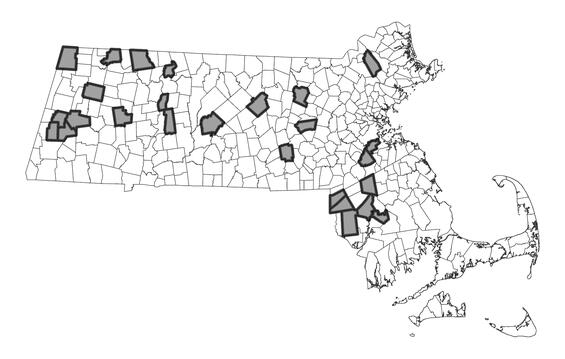- Scientific name: Platanthera flava var. herbiola
- Species of Greatest Conservation Need (MA State Wildlife Action Plan)
- Threatened (MA Endangered Species Act)
Description
Pale green orchid (Platanthera flava var. herbiola) is a perennial orchid (family Orchidaceae) known in Massachusetts from a variety of rich moist habitats.
Pale green orchid has a single stem, 15-60 cm (6-24 in) in height, which arises from a subterranean cluster of fleshy, tuber-like roots. The stem bears 2 to 5 broad, shiny green leaves, 7-20 cm (3-8 in) long, which are alternate, clasping, and sheathing, and decrease in size towards the inflorescence. The inflorescence is a loose spike of 10 to 40 small greenish or greenish-yellow flowers, which are interspersed with elongate leafy bracts. The flowers are irregular in shape, with a prominent hood, an oblong, sometimes wavy-edged lip, which widens at the base to form auricles, and an oblong, downward-pointing, nectar-bearing spur. Flowers are present from about mid-June to mid-July.
Long-bracted orchid (Coeloglossum viride), is a similar species, but it generally has longer bracts, a shorter, more sac-like spur, and darker, duller green leaves than pale green orchid.
Life cycle and behavior
This is a perennial species.

Population status
Pale green orchid is listed under the Massachusetts Endangered Species Act as Threatened. All listed species are legally protected from killing, collection, possession, or sale, and from activities that would destroy habitat and thus directly or indirectly cause mortality or disrupt critical behaviors. Pale green orchid is currently known from Berkshire, Bristol, Franklin, Hampshire, Norfolk, Plymouth, and Worcester Counties, and is historically known from Dukes, Essex, Hampden, Middlesex, and Suffolk Counties.

Distribution and abundance
The range of pale green orchid encompasses much of eastern and central North America, from the maritime provinces south to Georgia, and west to Ontario and Kansas.
Habitat
In Massachusetts, pale green orchid inhabits open to semi-shaded habitats in rich, moderately acidic wet areas subject to seepage, intermittent flooding, or water level fluctuation. Documented habitats for this species include wet meadows, boggy floodplains, open floodplain woods, river shore seeps, and hillside seeps. Associated species vary according to habitat type, but may include red maple (Acer rubrum), white ash (Fraxinus americana), false nettle (Boehmeria cylindrica), jewelweed (Impatiens capensis), skunk cabbage (Symplocarpus foetidus), cinnamon fern (Osmunda cinnamomea), regal fern (O. regalis), marsh fern (Thelypteris palustris), and sensitive fern (Onoclea sensibilis).
Healthy habitats are vital for supporting native wildlife and plants. Explore habitats and learn about conservation and restoration in Massachusetts.
Threats
A major threat to pale green orchid is over-shading or competition from invasive exotic or aggressive native species. Invasive species of particular concern include glossy buckthorn (Frangula alnus), Japanese barberry (Berberis thunbergii), and garlic mustard (Alliaria petiolata). Other threats to pale green orchid include any activities within its habitat that disrupt the natural hydrologic regime, degrade water quality, result in the destruction of plants, or result in major soil disturbance. Examples include water flow regulation, input of nutrients or pollutants from lawns or septic systems and trampling or damage from recreational use of the habitat.
Conservation
As with many rare species, the exact management needs of pale green orchid are not known. Sites should be monitored for invasions of exotic plants, particularly glossy buckthorn, Japanese barberry, and garlic mustard. If exotic or aggressive native plants are shading or out-competing pale green orchid, a vegetation control management plan should be developed in consultation with the MassWildlife’s Natural Heritage & Endangered Species Program. Pale green orchid locations that receive heavy recreational use (e.g., hiking, off-road vehicle use) should be carefully monitored for plant damage or soil disturbance; trails can sometimes be re-routed to protect the rare plant population. All active management of rare plant populations (including invasive species removal) is subject to review under the Massachusetts Endangered Species Act and should be planned in close consultation with the MassWildlife’s Natural Heritage & Endangered Species Program.
Contact
| Date published: | May 12, 2025 |
|---|